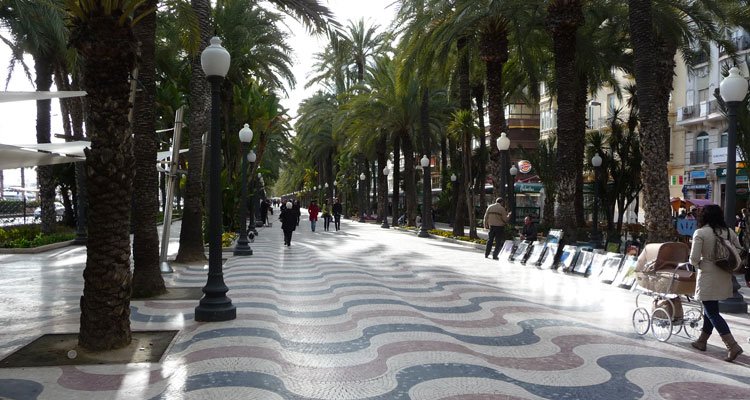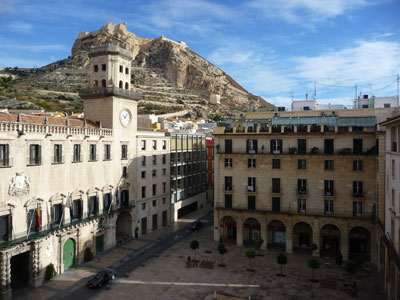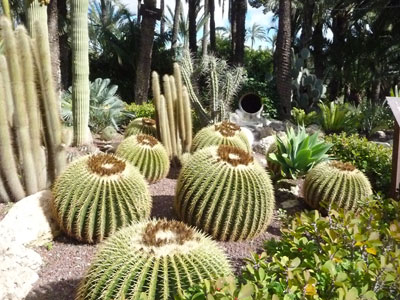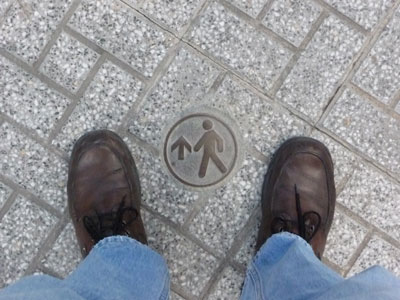Spending the day in Alicante
Alicante is a small city on the Costa Blanca, part of Spain’s Mediterranean coast. It is a popular stop for many of the large cruise ships traveling between Barcelona and Málaga.
You may wonder, ‘What can I do there for a whole day?’ Of course, you could go to the beach; there’s a nice one located an easy walk away from the pier (turn right when you exit the pier). Or you could take one of the excursions offered by the cruise line, but those can be expensive.
My husband and I spent a weekend in Alicante in February 2011, and I’d like to share what we saw, what we liked and what might be possible for you if you’re interested in going it on your own.
Points of interest
Alicante offers a number of attractions, including the Explanada de España, a pedestrian way paved with wavy black-and-tan mosaics and lined by palm trees; Mount Benacantil, with its Castell de Santa Bàrbara; the waterfront/beach area; the Mercado Central, and several museums, including the MARQ (museum of archaeology), the Museum of Contemporary Art, the Bullfighting Museum and the Museo de les Fogueres de Sant Joan, which celebrates the city’s annual festival of John the Baptist.
The Explanada, which runs parallel to the water’s edge, is located about half a block inland. Walk toward town from where the ships dock, and when you get to the end of the pier road, cross the high-traffic street, turn left and you’re there!
When the weather’s nice and a ship’s in, the walkway is lined with people selling art, postcards, scarves and other inexpensive souvenirs (though, except for the art, my guess is that most of these souvenirs are made in China).
Mount Benacantil is one of the most visible elements of Alicante, rising to more than 500 feet above sea level. The area has been settled for more than 5,000 years. On the slope of the hill, topped by a castell (fortress), is a park that is open every day, even when the fortress, itself, is closed.
You can easily reach the fortress on foot if you have average physical abilities. It’s hard to miss — when you look toward town from the water’s edge, it’s on the great big hill just to the right of the pier.
To get there, walk along the pier straight across the beach road and keep going straight into town. When you reach a T-intersection, turn left, then right and you should be at the base of the park. If you get a bit turned around, just keep going uphill.
We heard that there was an elevator (with a charge of a few euros) on Avenida Jovellanos, across the street from Playa Postiguet, but we didn’t ride it.
The fortress was built by the Moors in about AD 950 and has been remodeled over the years to suit successive rulers. During our visit, parts of the complex were being remodeled with the goal of opening for the 2011 travel season.
Many of the rooms within the fort have exhibits about the history of the structure and its military uses as well as on life there during various periods of occupation. The park is free to enter, but when the restoration is complete and the exhibits are open, there may be a charge to enter the fortress.
The fortress is a labyrinth of passages, ramps, stairways, tunnels, bridges and plazas, with 360-degree views from the top. There are two small stands with refreshments plus a full restaurant, so there are plenty of opportunities to rehydrate, which you will need to do if you climb to the top!
Museum visits
From the fortress, walk down the other side of the hill (away from the beach) along the road that the tour buses use. At the intersection at the bottom, cross the main road, walk one block straight ahead and you will see the MARQ (Plaza Dr. Gómez Ulla) on your left.
This is a great museum — very informative. It lays out the fascinating history of the town, and they have a nice English brochure, which you have to ask for at the ticket counter.
The exhibits are described in Spanish and the local dialect, but each has a single summary statement in English. Entry costs €3 or €4, depending on whether or not you want to see a special exhibit.
I thought the earlier material here was the best. There were Neolithic artifacts of all kinds, including shaped stones and bone tools.
At the museum’s café, you can listen to such American “classics” as “Light My Fire,” “Born in the USA” and “Achy Breaky Heart” while dining. When we ate there, we had large salads, burgers made with ground ham (an actual HAMburger) and, for dessert, natilla, a soft, custardy pudding delicately sprinkled with cinnamon. Our bill for two, with a soda and bottled water, totaled €18 ($25.50).
Another museum of interest is the Museo de Arte de Siglo XX La Asegurada (Museum of Contemporary Art) on Plaza de Santa Maria. Entry is free. Housed in a beautifully restored building from the 1600s, it contains art by Picasso, Dalí, Miró and other notable artists.
If you’re lucky enough to be in Alicante during the week of the summer solstice (June 21), you will be able to enjoy some of the festivities celebrating Saint John the Baptist. There are fireworks, parades, music, dancing and a special medieval market. However, if you can’t be there during the festival, you can visit the Museo de les Fogueres to see the papier-mâché heads made for the processions and watch videos of past celebrations. It’s a pretty interesting museum.
It is located on Rambla de Méndez Núñez, one of the major shopping streets that run perpendicular to the waterfront. Turn left from the pier road, then right, onto the Rambla.
The Museo Taurino (Bullfighting Museum) is located, not surprisingly, at the bullring. We didn’t get there, ourselves, because it was on the other side of Mount Benacantil, but we did see the bullring from the fortress.
Shopping and dining
If you’re in Alicante any day Monday through Saturday, you can stop in at the Mercado Central to see how the locals shop. This two-story building on Avenida Alphonso X El Sabio can be reached by walking north on Rambla de Méndez Núñez, away from the water. We found it crowded with locals and very few tourists. The bread, sausages, produce, fish, hams, cheeses and honey for sale seemed to be mostly local products.
If you’re in Alicante on a Sunday, there’s a flea market at the Plaza Ayuntamiento, two blocks up from the waterfront, near the main city hall building. The vendors sell stamps, coins, vintage postcards and books plus the usual flea market goods. The prices seemed reasonable to us.
We have two restaurant recommendations for Alicante. The first, La Taberna del Gourmet (Calle San Fernando 10), is open every day from 11 a.m. to midnight. (From the pier, cross the main street, walk one block straight ahead and turn left.) They have a daily tapas menu and a tasting menu, but we ordered off the regular menu.
The red wine was very good, and the water came in a lovely blue bottle. The grilled vegetable plate was a mix of thinly sliced veggies — acorn squash, eggplant, three kinds of mushrooms, asparagus, zucchini, bell peppers, shallots and artichokes — grilled without oil.
We also had very tender grilled small squids, caught locally. They were served with tiny octopuses and a vial of olive oil mixed with herbs to drizzle over them.
Our next course was a surprise. We thought we were ordering a Spanish tortilla, similar to a potato-and-egg frittata, but what came was a pile of French fries topped with two fried eggs and two thick slices of organ meat that were grilled on both sides but still pink inside. It was as soft as gelatin!
The waitress told us it was foie, but it didn’t taste or feel like any liver I’ve ever encountered before. The foie was a hit with my husband, but he has what I consider to be weird taste; I had just two bites.
This feast cost us €55 ($78), including tip. The next time I eat there I’ll order the Tapas Menu (€25 per person). It looked great, with lots of offerings.
The second restaurant, La Cueva de 1900 (Av. Alphonso X El Sabio 18), located down the street from the Mercado, is open for lunch and dinner. This place is all about meat, specifically pork. They had more than 200 hams hanging from the ceiling on hooks fastened to long metal pipes. Each ham had a little cup, like an upside-down umbrella, stuck into the bottom to keep the drippings from falling on the diners below.
They have an extensive menu, including a three-course meal, but we wanted something smaller so we chose ham sandwiches. First we were given four slices of bread, four slices of salchicha blanca (white sausage) and four chunks of something the waitress called queso de cerdo, literally, “pig cheese” (similar to head cheese but made with only meat and fat, no clear gelatin).
Then came the sandwiches, themselves — thin slices of salty ham on baguette, toasted until the bread was crunchy and the fat from the ham had melted and soaked into the bread. Excellent for a light meal! The two sandwiches, two sodas and appetizers cost €10.
Outside Alicante
If you want to travel farther afield, you can take the train to Elche (Elx) to see the Palmeral, a UNESCO World Heritage Site. The train leaves once per hour from the main station in Alicante and takes about 20 minutes to reach Elche Parque (it’s the third stop).
The people in the ticket office at the station spoke excellent English and were very helpful. The round-trip fare was €4.60 per person.
To get to the train station from the port, allow 20 to 30 minutes’ walking time for an average walker. At the end of the pier road, turn left on the pedestrian way that parallels the heavily trafficked street, then turn right onto Avenida del Doctor Gadea, then left at Avenida Alphonso X El Sabio. The train station is on the right. Or you can always take a taxi.
The Palmeral of Elche is a living example of palm groves fed by a Moorish irrigation system. The region has preserved many of the irrigation ditches, which have been in existence since about AD 900, though the cultivation of palm trees at this site started much earlier.
Departing the train station at Elche Parque, turn left and walk about two blocks to the Municipal Park, full of palm trees and families. There’s a nice map display there to point you in the direction of the visitors’ center, a block to the left, on the edge of the park. The helpful staff spoke English and gave us maps and brochures to guide us through the rest of our visit.
Across the street is the Museo Arqueológico y de Historia de Elche (Museum of Archaeology & History of Elche), or MAHE (admission, €3). This was even better than the MARQ in Alicante. Although both museums are fairly new and the exhibits are nicely displayed, the MAHE had full descriptions in English and plenty of light to read them.
This area was settled in Neolithic times, and by the Bronze Age there were villages that traded with others around the Mediterranean. Artifacts reflect Greek and Roman influences. A chubby, winged marble Cupid with a bow and a quiver full of arrows, carved before AD 100, surely served as the perfect example for Raphael’s cherubs more than 1,500 years later.
The museum, itself, is housed in the building of a former alcázar. It’s a great background for the exhibits. There’s a handy restaurant in the courtyard outside the museum, near the entrance.
Just a block away is the Basilica de Santa María (entry is free). Its opening hours vary, but if it’s closed, step around the corner to the small door of the bell tower on the right. You can sneak a peek into the basilica from the ground floor of the bell tower.
The church is lovely, with a painted dome and lots of Spanish Baroque gilding.
We climbed the bell tower (€2) for a wonderful view of the city. The palm groves are easy to see from the top.
The church hosts the city’s other attraction recognized by UNESCO, the medieval Mystery Play of Elche. In August every year (dates vary) this play, which commemorates the assumption of Mary into Heaven, takes place inside the basilica. It involves processions through the street with the church’s statue of Mary.
If you’re in the area during the festival, I think it would be worth a trip just to see it. It’s supposed to be quite a spectacle, with several parades over a 13-day period as well as the performance of the play.
Amongst the palms
Our main goal in visiting Elche was to see the Palmeral and learn about the palm groves, so we walked over to El Huerto del Cura National Artistic Garden (admission, €5) to see some palm trees. There are thousands of plants there, mostly palms, cacti and succulents.
In the cactus garden are the largest cacti I have ever seen (even after living in San Diego and traveling throughout the American Southwest). There are four of them, all 20 meters high and interwoven to create a natural screen against the sun. These cacti are like trees, with trunks two feet in diameter at ground level and branches every four or five feet.
The city has developed a 2.6-kilometer walk through the palm groves, which we followed to see the trees and irrigation system. The way was clearly marked with symbols on the ground pointing out the direction to go. The walk takes you through active groves, both date palm and oil palm. Part of the path actually runs over the irrigation ditches, the water now carried in pipes.
We saw the older palm trees (200-300 years old) in rows on either side of the irrigation ditches as well as fields of smaller trees more recently planted.
The city emphasizes that they have managed to integrate urban uses in with the date groves, and there are schools, residences, hotels and parks nestled amongst them.
When we had our fill of the palm groves, we wandered back into the Old Town to see the city hall and the adjacent clock tower. The clock tower has two bells, each with its own bell ringer. “Ring” may not be the best word to describe the sound of the bells, which sounded very clunky, like buckets being hit with a hammer.
We had taken the 11 a.m. train to Elche and we were back to Alicante by 6 p.m., so it would certainly be possible to do this as a day trip from a ship. If you took a taxi to and from the train station, caught an earlier train and didn’t loll around Elche the way we did, you could probably do this in six or seven hours, round trip.
So get off the ship and enjoy Alicante!




